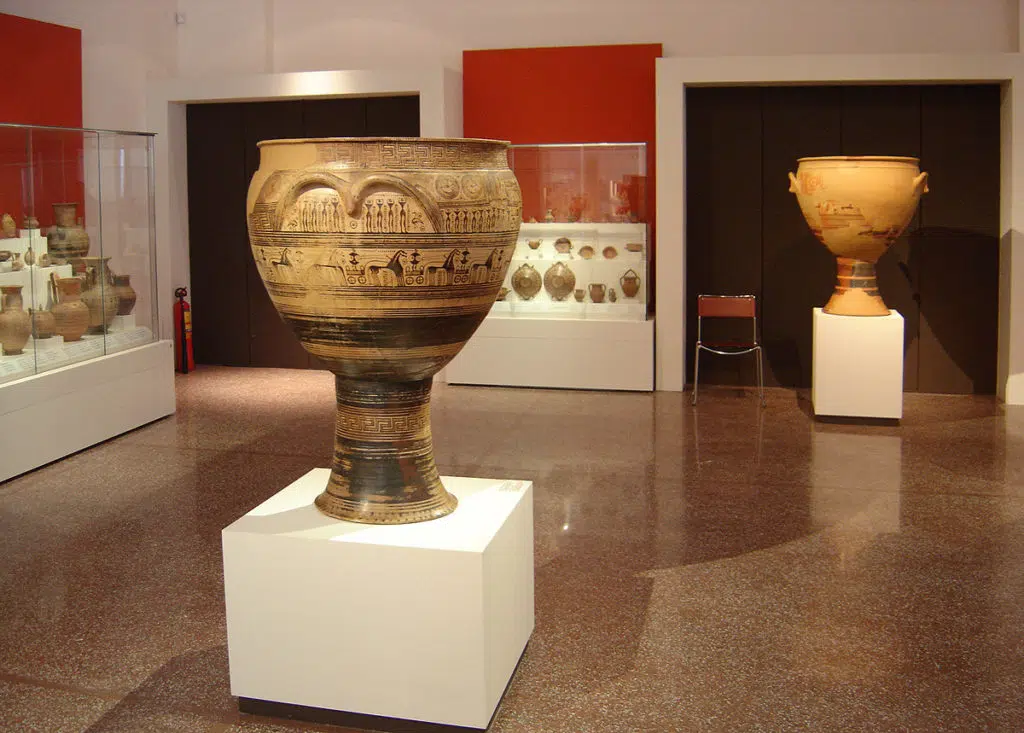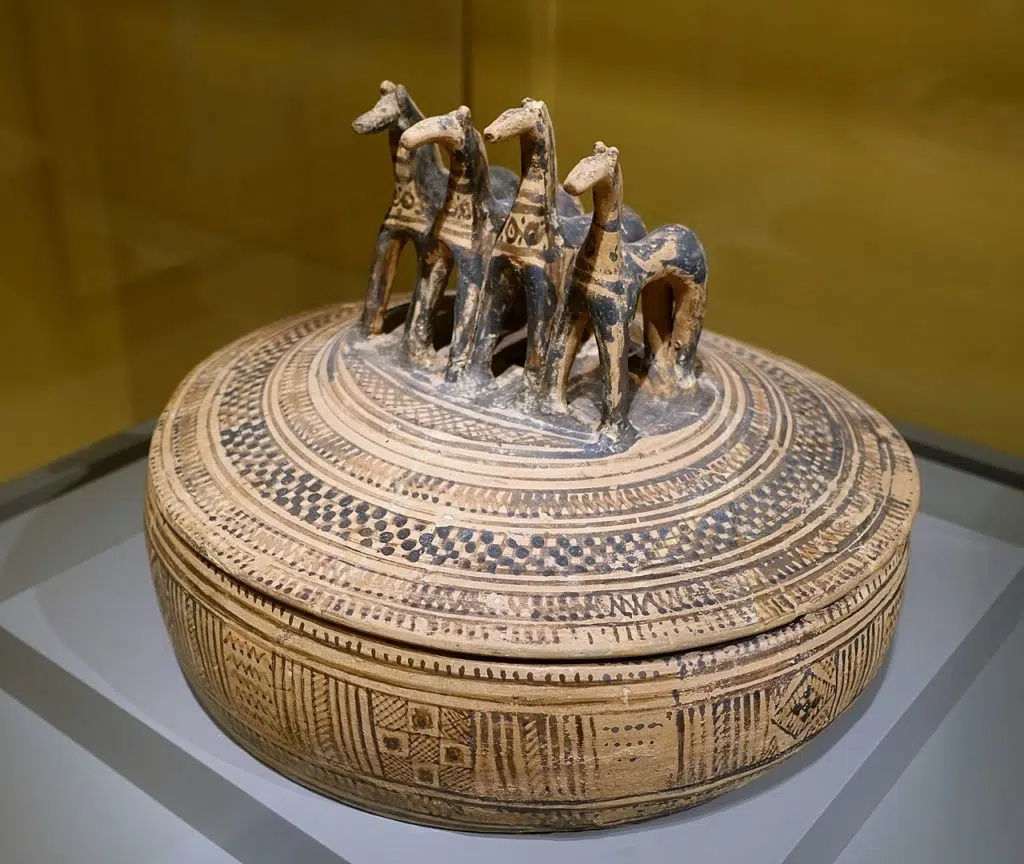
The Greek Geometric Period is a lesser known era in history. However, it ushered ancient Greece from the Dark Age to the Classical Period.
It was a period when Greek society was transformed and the proto-urban society re-appeared. This was a time of innovation. Influences from the Mycenaean past were still felt, while peoples from the Eastern Mediterranean migrated westwards.
Contact with Eastern peoples brought about social upheaval, as there was fast population growth, which, consequently, led to overcrowding and political tensions. These resulted in social, economic, and artistic changes.
These artistic changes in ancient Greece were manifested in the geometric motifs in decoration. The decorative forms, rectilinear, and curvilinear, were drawn on vases and pots with the aid of instruments. These are the main surviving works of art of the era. Hence, later historians conventionally named it the Geometric Period.
The Geometric Period was also the era in which Homer‘s epics the Iliad and Odyssey were written. These later served as the foundation of Western literature.
Opinions as to when the Geometric Period actually began differ among historians. Some place it around 1050 BC while others believe it was in 900 BC. They agree, however, on when it ended, placing it around 700 BC, when the Classical period started.
Geometric shapes influenced from Eastern cultures
Geometric shapes did not appear for the first time in art in the Geometric period. Triangles, squares, spirals, circles, and rhombi had been used in earlier cultures such as in Mesopotamian pottery during the 5th and 4th millennium BC. Even naturalistic subjects, such as landscapes and animals, were drawn with geometric patterns.
Similar patterns were adopted in other areas of West Asia and Asia Minor, but they were not limited in the Middle and Near East. In Central Europe and Greece, Neolithic pottery was decorated with geometric shapes, and so were many vessels of the Minoan and Mycenaean civilizations.
However, what distinguishes Greek geometric art is the method of arrangement in the surface of the vessel. In previous ages, geometric patterns were instinctive linear symbols of a powerful and incomprehensible nature in a continuous and uncontrolled flow.
In Greek geometric art, there is harmony, rhythm, order, and reasonable natural balance rather than randomness. This is the first known outbreak of the great intellectual leap of Greece from which subsequent Greek thought and art were born.

Geometric art was not limited to clay pots and vases. Works of art were created with bronze as well. Bronze human figurines, animals, and birds appeared, initially rare and clumsily made. However, as time passed, they became clearer as to their intent, i.e. depicting a warrior or a woman.
Different styles and workshops emerged depending on the region they were made, such as Attic, Laconian, Corinthian, etc. Characteristic examples are the figurines of horses, frequently represented on open work or solid bases. Many of the bases have patterns on the underside and were perhaps used as seals. Also pieces of jewelry such as pendants, fibulae, bracelets, etc. are found in various types.
Such minor bronze works have been found in graves as offerings. Apart from those, large bronze objects from the Geometric Period have been found. Excavations in sanctuaries have unearthed large tripod cauldrons with round handles adorned with figurines of warriors, charioteers, and animals from the 9th century BC. Their three high legs are decorated with zigzag lines, circles linked by tangents, spirals, etc.
Styles and themes of Geometric Period art
While the Geometric style was spread throughout the regions of the ancient Greek world, Attica had been the most prominent center. The most common themes were funerary, with figures painted solid black using the skiagraphy technique (shadow painting). There were depictions of prothesis (the laying out of the body) and the ekphora (funeral procession) of the deceased.
Chariot racing was also a common theme, along with scenes depicting a circular dance in honor of a deity. Another regular theme was shipwrecks while mythological themes were rarer.
The most important samples, funeral offerings, and the huge funerary vases have been found at the Dipylon cemetery in Athens. The geometric decoration is almost always drawn with a glossy black or brown color on the yellowish surface of the clay and characterized by geometric, usually straight designs such as triangles, squares, rhombi, and crosses decorating the horizontal surrounding strips of the vase.
Greek geometric art was an achievement in ceramic art. It is where the concept of the pure forms and ways of the monumental composition emerged, giving original solutions to the problem of placing three-dimensional forms on the two-dimensional space of the painting surface.
The monochrome rendering of the subjects, the display of bodies and objects from the most visible and easily understood side, and the simultaneous presentation of an art form from different sides—such as torso on the front, head and feet in profile—as well as the organization of works with more reasonable and spiritual criteria rather than aesthetic are principles that 20th century art discovered and reassessed.
Modern art waves, particularly the Analytical and Synthetic Cubism and the Geometric Abstract Art trends, have been based on similar concepts.
Homer’s epics and Hesiod
Most attempts at understanding the Geometric Period are predominantly based on Homer’s epics, the Iliad and Odyssey, and partly on the writings of Hesiod, a historian. However, the society delineated in the Homeric poems is, most probably, that of the Mycenaean Age, that is, before the end of the 12th century BC.
Through thorough study, experts of the 20th century have reached different conclusions. The poems themselves, composed between the mid-8th and mid-7th centuries BC, derive from the oral poetry tradition. They must not be related either to the Mycenaean Age, as formulated from archaeological finds and the texts of Linear B script, or the society of the Archaic period.
On the contrary, they probably concern the conditions prevailing during the Late Dark Age, with particular focus on the world of the aristocrats, their way of life, and ideas. The works of Hesiod, and especially Works and Days, provide information about the life of the peasants towards the end of the 8th century BC.
As in Geometric Period art and its influence on modern art, Homer’s poems have laid the foundation of Western literature.
See all the latest news from Greece and the world at Greekreporter.com. Contact our newsroom to report an update or send your story, photos and videos. Follow GR on Google News and subscribe here to our daily email!



